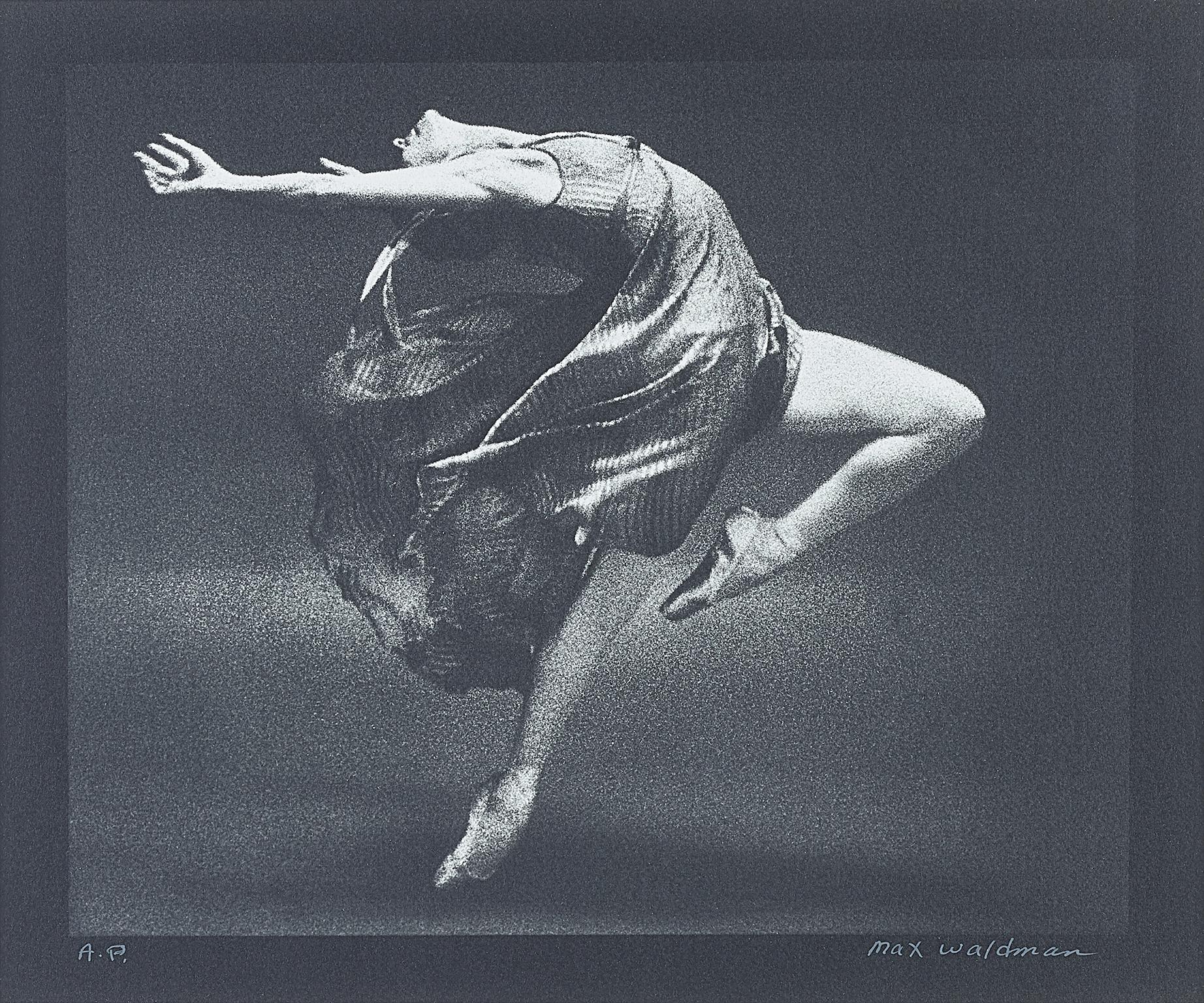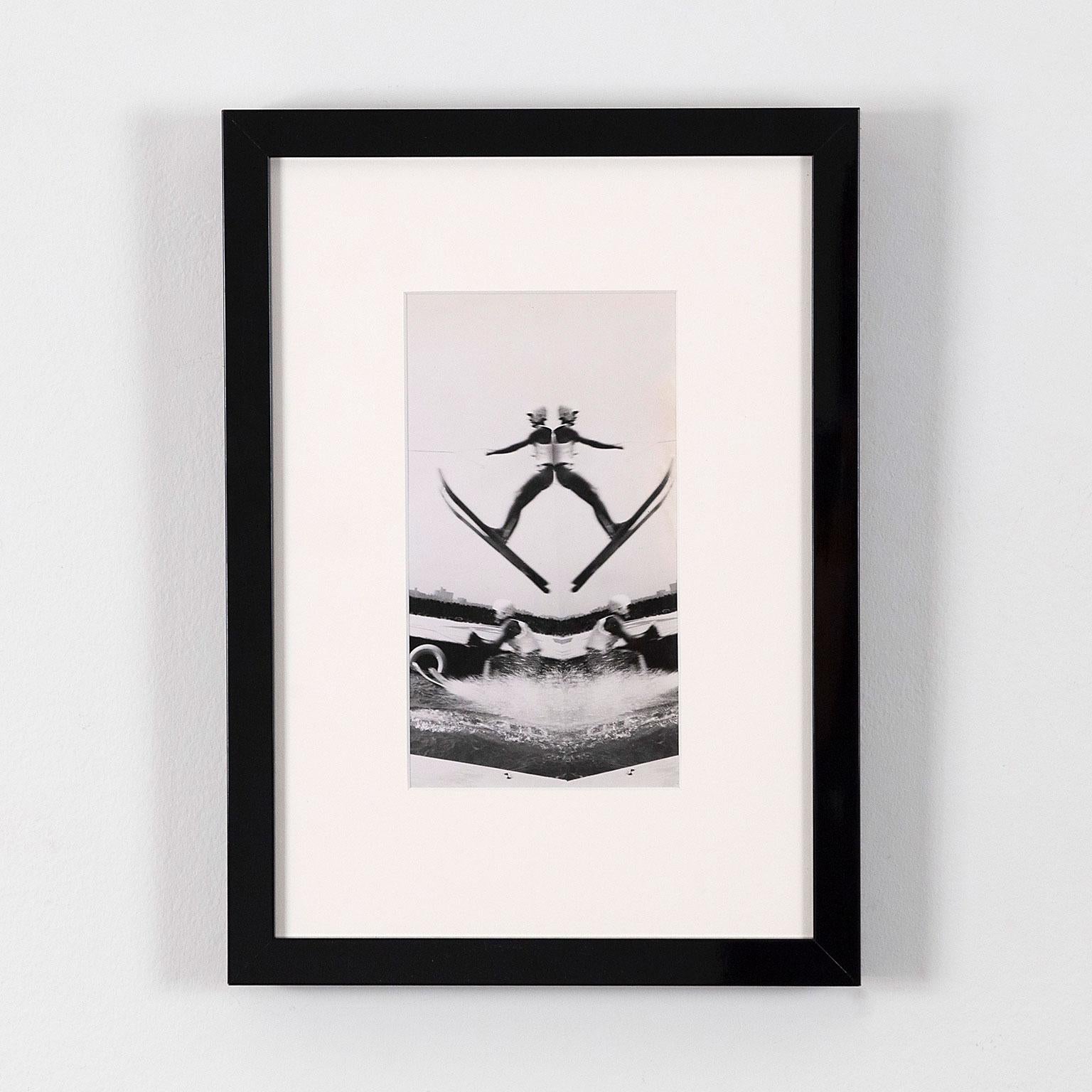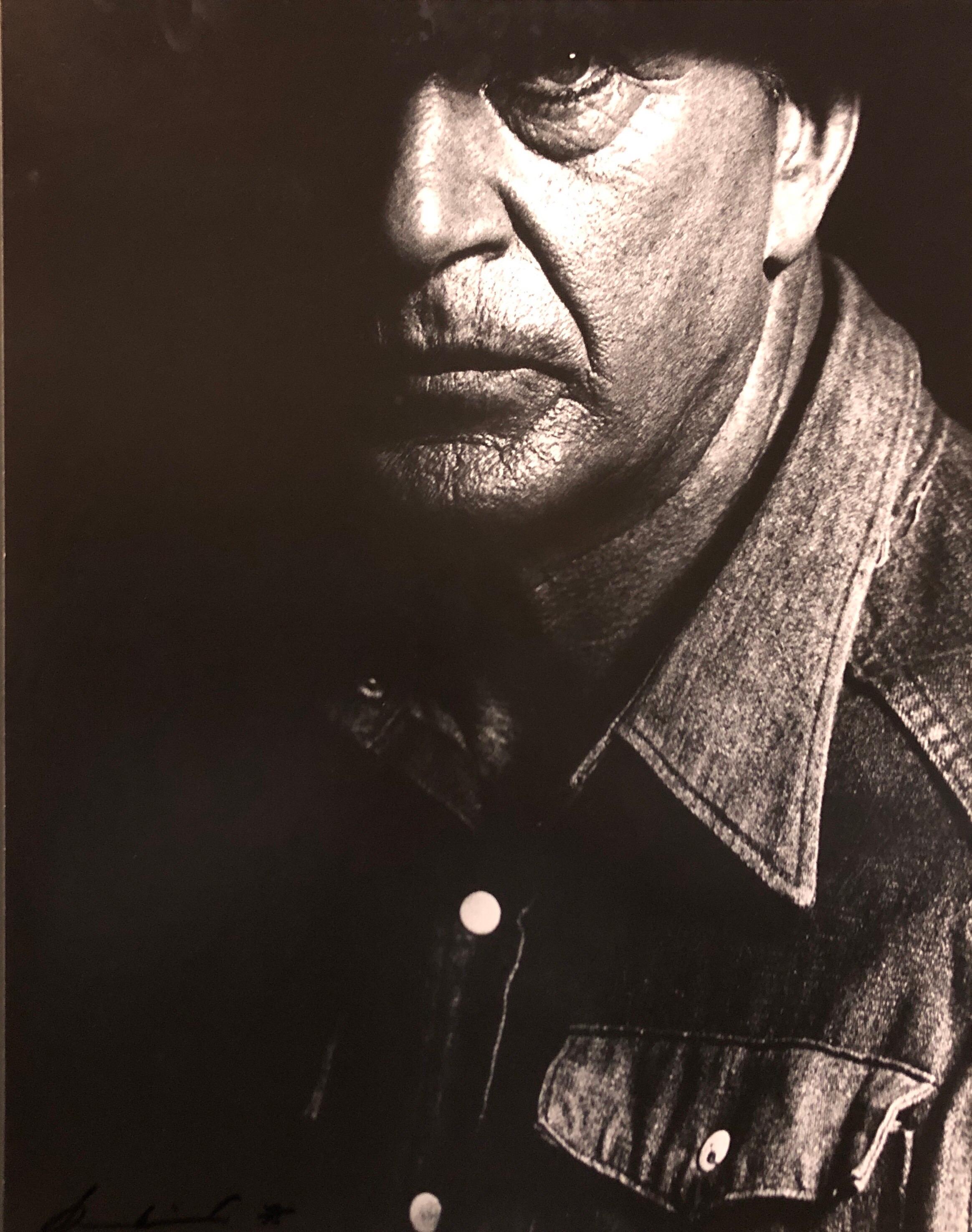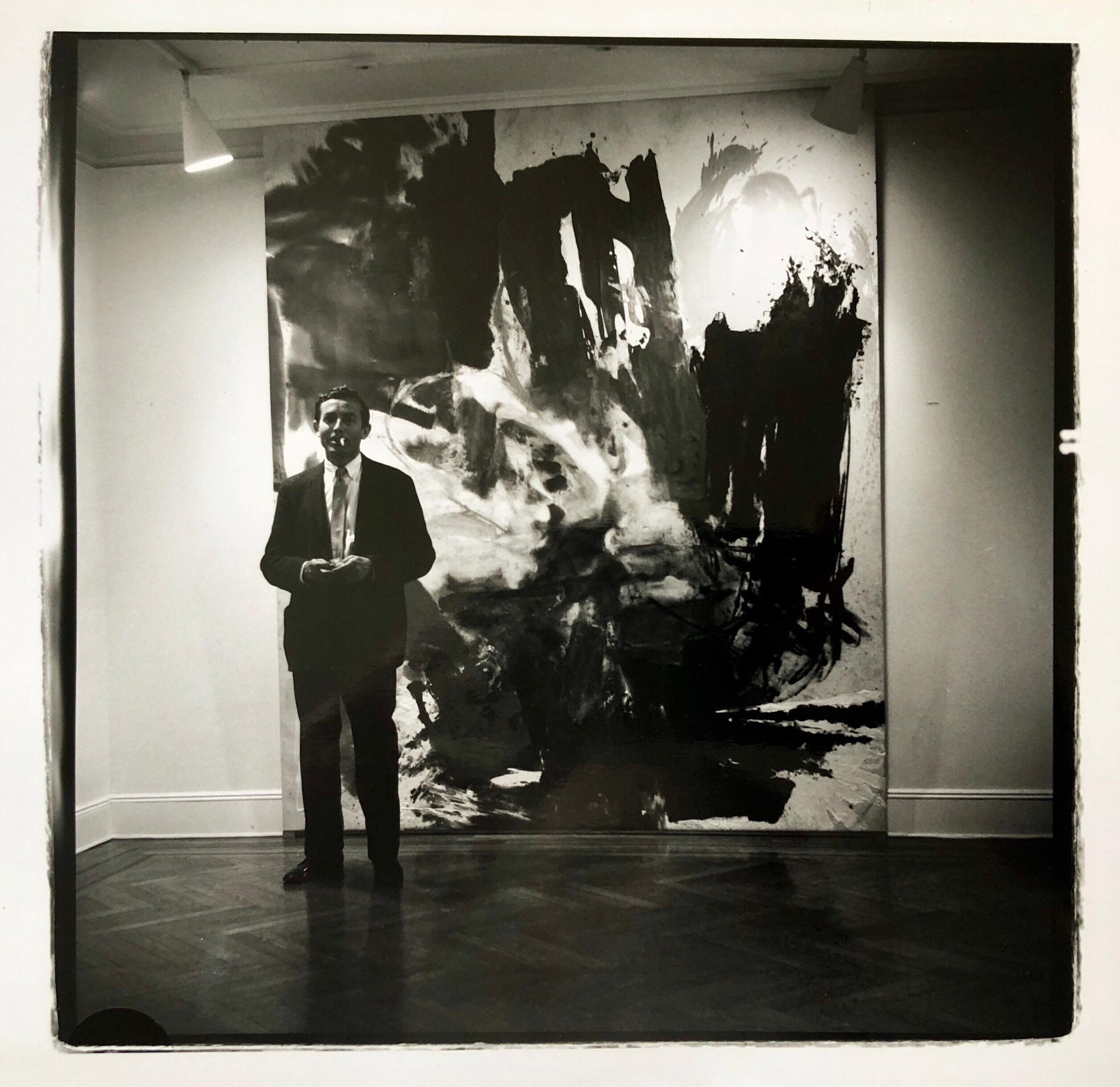Items Similar to Weegee "A Trip to Mars"
Want more images or videos?
Request additional images or videos from the seller
WeegeeWeegee "A Trip to Mars" 1943
1943
About the Item
While many first associate Weegee (aka Arthur Fellig) with New York City crime scenes, perhaps a broader and more consistent theme is that of spectacle and/or urban entertainment.
The origins of his nick-name and reputation date back to the 1930s when he became the first New York City press photographer to obtain permission to install a police radio in his car. Following the city's first responders and documenting their duties, Weegee had unprecedented access to New York’s fires, crimes, debaucheries and of course, murders.
During the first decade of his career these unflinching urban tragedy or crime images paid Weegee's bills, but as he became more financially independent he was more inspired to pursue photographs on his own agenda. While his oeuvre is vast, Weegee was especially drawn to entertainment: nightlife, circuses, the theatre, showgirls, city thrills, the cinema etc.
Some of Weegee's most dynamic and tender (and under-appreciated!) images are related to simply having fun (in a crowd). He was not confined to one neighbourhood or demographic. He captured action, faces and events from Coney Island to the Bowery and Greenwich Village, to Times Square and Harlem.
In “A Trip To Mars,” Weegee depicts a multi-generational group crowding around a large telescope in Times Square, NYC. This image was taken at the beginning of the 1940s, just a few years before the artist would relocate to Hollywood, CA. In and around Times Square, Weegee’s influences converged.
This image presents a well-dressed group in the perennially dynamic center of New York: Times Square. Not surprisingly this was an ideal zone for Weegee as in the same block a nexus of debauchery, pop-culture figures, and raucous night life was emerging. There was no better place for the photographer, famous for zeroing in on how a variety of spectators could react to the same event or situation. Contrast the expression of anticipation and envy on the young woman's face on the far left to the look of satisfaction and amusement of the elderly lady in the center. This range of figures and emotions, is evocative of Weegee's best New York "crowd" or "entertainment" images.
Questions about this artwork? Contact us.
“A Trip to Mars, Times Square, New York”
Gelatin silver print
USA, circa 1943
Photographer's credit and '47th Street' stamps verso.
9.5"H 7.75"W (work)
16"H 14.5"W (framed)
Detailed condition report upon request.
- Creator:Weegee (1899-1968, American)
- Creation Year:1943
- Dimensions:Height: 16 in (40.64 cm)Width: 14.5 in (36.83 cm)
- Medium:
- Movement & Style:
- Period:
- Condition:
- Gallery Location:Toronto, CA
- Reference Number:
Weegee
Arthur Fellig, who later assumed the pseudonym Weegee, was a photographer and photojournalist, best known for his gritty black-and-white imagery taken on the streets of New York City. Born in 1899 in what is now the Ukraine, he arrived in the United States with his family in 1909, and settled in Brooklyn. After working in a variety of photography-related jobs, he struck out on his own at the age of 35 as a self-taught freelance photographer, selling his work to publications like the Herald Tribune, the Daily News, the Post, and the Sun. Weegee worked mostly at night, usually around Manhattan Police Headquarters. He was the only freelancer in New York to obtain permission to install a police radio in his car. As a result, he was often the first to arrive at the scene of the many crimes he photographed, often before the police themselves had responded. Moreover, he traveled with a makeshift darkroom in the trunk of his car, so he could produce, and then sell, his images faster than his competitors. But crime was not his only subject. He also photographed socialites at high-society events, circus performers, street life, tenement housing conditions, and many other facets of New York life. For a number of years he traveled extensively in Europe, and worked for the London Daily Mirror. He later returned to New York City, where he died in 1968. Th Museum of Modern Art began collecting his work in 1943, and featured it in several exhibitions. His work was also shown at the New York Photo League, and the International Center of Photography hosted a retrospective of his work in 1998. He has been featured in exhibitions at European venues such as the Kunsthalle Vienna, Austria's Flatz Museum, and the Multimedia Art Museum in Moscow. Several monographs of his work have been published.
About the Seller
4.8
Vetted Seller
These experienced sellers undergo a comprehensive evaluation by our team of in-house experts.
Established in 2009
1stDibs seller since 2015
176 sales on 1stDibs
Typical response time: <1 hour
- ShippingRetrieving quote...Ships From: Toronto, Canada
- Return PolicyA return for this item may be initiated within 3 days of delivery.
More From This SellerView All
- Waterski JumperBy WeegeeLocated in Toronto, OntarioArthur Felling, better known as Weegee (1899-1968) is America's premiere photojournalist and one of the last century's most influential photographers. He would become famous, beyond...Category
1950s American Modern Black and White Photography
MaterialsSilver Gelatin
- Weegee "Distortion: Stripes"By WeegeeLocated in Toronto, OntarioInnovative, provocative, inimitable - these are just a few of the words to describe America's boldest photographer. Arthur Fellig, better known as Weegee (1899-1968) was a ground-breaking, successful (and notorious) photojournalist. His images shot on the streets of New York City are iconic and influential. In the 1930s he became the first New York City press photographer to obtain permission to install a police radio in his car. This allowed him to follow the city's first responders and to document their duties; responding to fire, crime, debauchery and of course, murder. By the early 1940s Weegee was experiencing fatigue with crime reportage. Ironically, this was also the point when he finally began experiencing professional validation and acclaim, to the point of being a minor celebrity. Notably in 1941 he was included in The MoMA's seminal "50 Photographs by 50 Photographers" (curated by Edward Steichen). The museum would also acquire five Weegee photographs...Category
1940s American Modern Black and White Photography
MaterialsSilver Gelatin
- Weegee "Sailor and Girl Kissing"By WeegeeLocated in Toronto, OntarioWeegee (1899-1968) was equally fascinated and inspired by cinema and all of its tangents, from Hollywood movie stars to ordinary civilians going to the movies. While Weegee is typically associated with crime/disaster images, the broad theme of "entertainment" is a major component of his oeuvre. An interesting and provocative sub-genre of his cinema-related work are his images of couples (often heavy-petting) in movie theatres. Recent scholarship has established that many of Weegee's supposed clandestine images were actually staged or arranged with friends or co-operative strangers. Nevertheless, Weegee created these photographs in the dark with an array of clever techniques including infrared film, filtered flashbulb and triangular prism lens. Employed in shots such as this one, the prism lens would allow the artist to “see around corners,” useful at times when his subjects were in compromising locations. These images of kissing couples, Weegee wrote in 1959, were “his best seller, year in and year out.” "Sailor and GIrl at the Movies...Category
1940s American Modern Black and White Photography
MaterialsSilver Gelatin
- GardeniaBy Robert MapplethorpeLocated in Toronto, OntarioRobert Mapplethorpe earned his place in the canon from his incredible output of images that ranged from beautiful to brutal. Mapplethorpe was one of the key artists who helped elevate photography from image-making to fine art. Mapplethorpe (1946-1989) fearlessly depicted the body (his own, friends' and lovers') in a way that positioned his work in line with masters such as Reubens, Courbet and Eadweard Muybridge to mention a few. Despite the sometimes shocking content of his work, Mapplethorpe's photographs possess a formalist quality with their undeniable beauty and strict compositions. From 1978-1981, Mapplethorpe created thirty-nine black and white photographs that make up his acclaimed XYZ Portfolios. While each portfolio is a distinct exploration of Mapplethorpe's signature subject matter, when combined, XYZ Portfolios serves as a definitive and in-depth representation of his mature and most sought-after, period. (Of the portfolios, X explores homosexuality and sadomasochism; Y features floral still life; while Z showcases portraits of Black men) Click here to see a portrait from the Z portfolio. In 2012, the XYZ Portfolios were shown in an exhibition at LACMA and presented in three rows (X on top, followed by Y in the middle, and Z below) as Mapplethorpe had envisioned them in 1989. "Gardenia" is one of thirteen images from the Y Portfolio, featuring a fragrant and graphic flower. Shot overhead, this tranquil image captures a delicate flower subtly floating in a dark, contrasting bowl. Aside from the flower's shadow below, the still water is nearly inconspicuous, contributing to the air of grace and elegance that this piece evokes. While the depiction is straightforward, Mapplethorpe's contrasts lead to a more ambiguous image; is this actually a flower or some alien specimen being examined? This powerful black and white image is a prime example of Mapplethorpe's work, highlighting his studio-centric practice as well as his refined and meticulous printing. This is a rare opportunity to acquire an iconic work by one of the most influential photographers of the 20th Century. Caviar20 is proud to be offering this monumental and important piece. "Gardenia" USA, 1978 Gelatin silver print Signed in ink by Michael Ward Stout and credited and dated on photographer's estate stamp, mount verso. 13.25"H 12.75"W (image) 16.75"H 16"W (framed) Very good condition Provenance: Xavier Hufkens...Category
1970s American Modern Black and White Photography
MaterialsSilver Gelatin
- Groom Kissing His BrideBy Diane ArbusLocated in Toronto, OntarioDiane Arbus (1923-1971) is one of the most influential and daring photographers of the 20th century. Arbus is best known for her unique form of documentary portraiture. She explored the uncanny, the marginalized, and the idiosyncratic characters who defied mid-century conformity. Her work has influenced some of the most renowned photographers of our time including Nan Goldin. While her career launched in the fashion world, it was years after quitting commercial photography (circa 1956) that she found her voice as an artist. With camera in hand, she followed her fascination with the eccentric individuals and oddities of New York City. Ultimately rejecting her affluent, sheltered upbringing and the mainstream fashion industry to create her own definitions of beauty. Arbus’ portraits were considered incredibly provocative for their bold representations of sexuality, chaos, and grit. She fully immersed herself within the queer and alternative communities she documented, engaged with a curious balance of mystery and homage. Shot in 1966, "Groom Kissing His Bride" is a prime example of her uncanny ability to capture even the most traditional moments (a wedding) through a lens of surrealism. Love and tension confront each other as the groom kisses the bride with an attacking passion. Her likeness disappears behind his embrace and their newlywed bodies merge together. This work also contains Arbus’ visual trademarks – a black and white palette, a square crop, and a hard flash that flattens the aesthetic wonderland of New York. Today, Arbus' work is celebrated in many major museum collections including the Art Gallery of Ontario, Art Institute of Chicago, National Museum of Modern Art (Tokyo), and Centre Pompidou (Paris). "Groom Kissing his Bride, NYC" USA, 1966 Gelatin-silver print Printed by Neil Selkirk Stamped 'A Diane Arbus photograph...Category
1960s American Modern Black and White Photography
MaterialsSilver Gelatin
- One PistolBy Andy WarholLocated in Toronto, OntarioAndy Warhol began using the big-shot Polaroid camera in 1971 and continued using it religiously until his death in 1987. Despite the camera being discontinued in 1973, he continued t...Category
1980s American Modern Black and White Photography
MaterialsPolaroid
You May Also Like
- "Natalia Makarova " vintage photography. "Serge Lifar "Located in CANNES, FR"Natalia Makarova " is an gelatin print , silver bromide, numbered and signed photograph offered to " serge Lifar " by Max Waldman . Artist proof . Ser...Category
1970s American Modern Black and White Photography
MaterialsSilver Gelatin
- Vintage Silver Gelatin Print Photograph Gary Cooper, His Last Photo, SignedLocated in Surfside, FLThis is a vintage black and white photograph (shot in 1961 and printed in 1975) of famed actor Gary Cooper by internationally renowned PhotographerSherman Weisburd. This Vintage photograph was developed from the original negative and is the last portrait photo taken before his death. This photo was selected as a possible cover for Good Housekeeping Magazine. It is hand signed in marker, lower right by Sherman Weisburd. Sherman Weisburd, known for his album cover photos of the 1960s and '70s and advertising work of the early '70s. Photographer for Playboy Magazine, TV Guide (Sonny & Cher), and Viva Magazine. Grammy nominated for his photo of Charles Aznavour, He shot Arlo Guthrie for the cover of Alice's Restaurant, Betty Ford for Ingenue magazine, Marilyn Monroe for Modern Screen magazine. He also shot Ashford & Simpson and was a cinematographer for Universal and Paramount pictures. Gary Cooper was an Oscar winning American actor. A major movie star from the end of the silent film era through to the end of the golden age of Classical Hollywood. Throughout his career, he sustained a screen persona that represented the ideal American hero. In the early 1930s, he expanded his heroic image to include more cautious characters in adventure films and dramas such as A Farewell to Arms (1932) and The Lives of a Bengal Lancer (1935). During the height of his career, Cooper portrayed a new type of hero—a champion of the common man—in films such as Mr. Deeds Goes to Town (1936), Meet John Doe (1941), Sergeant York (1941), The Pride of the Yankees (1942), and For Whom the Bell Tolls (1943). In the postwar years, he portrayed more mature characters at odds with the world in films such as The Fountainhead (1949) and High Noon (1952). In his final films, Cooper played non-violent characters searching for redemption in films such as Friendly Persuasion (1956) and Man of the West (1958). Cooper had a series of romantic relationships with leading actresses, beginning in 1927 with Clara Bow, who advanced his career by helping him get one of his first leading roles in Children of Divorce In 1929, while filming The Wolf Song, Cooper began an intense affair with Lupe Vélez...Category
1960s American Modern Portrait Photography
MaterialsSilver Gelatin
- Vintage Print Silver Gelatin Signed Photograph Friedl Dzubas New York ArtistBy Fred McDarrahLocated in Surfside, FLThis is a photo of Friedl Dzubas (Abstract Expressionist) at Castelli Gallery, signed in ink and with photographer stamp verso and hand written title.. Over a 50-year span, McDarra...Category
1950s American Modern Black and White Photography
MaterialsBlack and White, Silver Gelatin
- Large Vintage Print Silver Gelatin Signed Photograph Terminal Patient Bird CoverBy Fred McDarrahLocated in Surfside, FLMan in Wheel Chair , Titled Terminal patient, Bird Cover Over a 50-year span, McDarrah documented the rise of the Beat Generation, the city’s postmodern art movement, its off-off-B...Category
20th Century American Modern Black and White Photography
MaterialsBlack and White, Silver Gelatin
- Feminist Protesting Vietnam WarBy Fred McDarrahLocated in Surfside, FLFeminist T. Grace Atkinson Being Arrested As She Demonstrates Against Richard Nixon's War in Vietnam October 23, 1972 Over a 50-year span, McDarrah documented the rise of the Beat Generation, the city’s postmodern art movement, its off-off-Broadway actors, troubadours, politicians, agitators and social protests. Fred captured Jack Kerouac frolicking with women at a New Year’s bash in 1958, Andy Warhol adjusting a movie-camera lens in his silver-covered factory, and Bob Dylan offering a salute of recognition outside Sheridan Square near the Voice’s old office. Not just a social chronicler, McDarrah was a great photo-journalist. For years, McDarrah was the Voice's only photographer and, for decades, he ran the Voice’s photo department, where he helped train dozens of young photographers, including James Hamilton, Sylvia Plachy, Robin Holland and Marc Asnin. His mailbox was simply marked "McPhoto." An exhibit of McDarrah’s photos of artists presented by the Steven Kasher Gallery in Chelsea was hailed by The New York Times as “a visual encyclopedia of the era’s cultural scene.” artists in their studios, (Alice Neel, Philip Guston, Stuart Davis, Robert Smithson...Category
20th Century American Modern Black and White Photography
MaterialsBlack and White, Silver Gelatin
- Vintage Silver Gelatin Signed Photograph Samuel Gottscho Garden Flowers Photo NYBy Samuel GottschoLocated in Surfside, FLVintage hand signed and stamp signed with the photographers stamp and numbered photo of Moccasin Flower. Samuel Herman Gottscho (February 8, 1875 - January 28, 1971) was an American architectural, landscape, and nature photographer. Samuel Gottscho was born in Brooklyn in New York City. He acquired his first camera in 1896 and took his first photograph at Coney Island. From 1896 to 1920 he photographed part-time, specializing in houses and gardens, as he particularly enjoyed nature, rural life, and landscapes. After attending several architectural photograph exhibitions, Gottscho decided to perfect and improve his own work and sought out several architects and landscape architects. After twenty-three years as a traveling lace and fabric salesman, at an age when most people would have given up their youthful dreams, Gottscho became a professional commercial photographer at the age of 50. His son-in-law William Schleisner joined Gottscho in his business in 1935. During this time his photographs appeared in and on the covers of American Architect and Architecture, Architectural Record. His portraits and architectural photography regularly appeared in articles in the New York Times. His photographs of private homes in the New York and Connecticut suburbs often appeared in home decoration magazines. From the early 1940s to the late 1960s, he was a regular contributor to the Times of illustrated articles on wildflowers. the meticulous, adoring pictures of New York City architecture and interiors that he took at his creative peak in the late 1920's and early 30's are finding a new audience, placing him more firmly in the ranks of the great architectural photographers of his day, like Ezra Stoller, Julius Shulman and Ken and Bill Hedrich. the Museum of the City of New York, which has one of the largest archives of Gottscho's work, showed about 150 of his best city scenes in an exhibition called "The Mythic City: Photographs of New York...Category
Mid-20th Century American Modern Landscape Photography
MaterialsSilver Gelatin
Recently Viewed
View AllMore Ways To Browse
Contact To Contact
Black Block
How To Contact
Famous Black Dress
American Vintage White Dress
White New Look Dress
1930s White Dress
1940s White Dress
A Vintage Murder
A 1940s Lady
Vintage 1940S Cars
Vintage Inspired White Dress
Circus 1940
Vintage Entertainment Center
Radio 1940
Life On Mars
1930s Vintage Radio
Vintage Circus Figures





